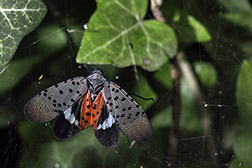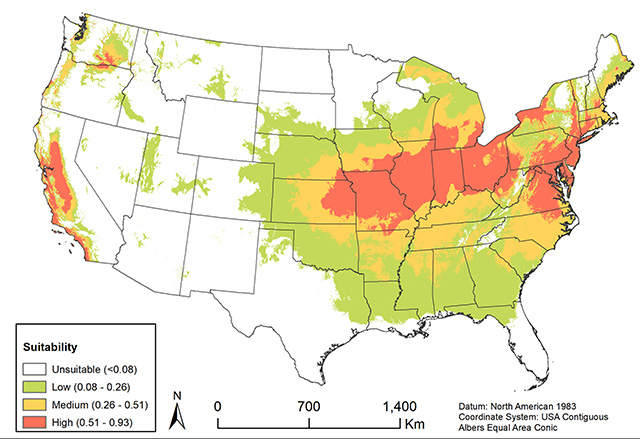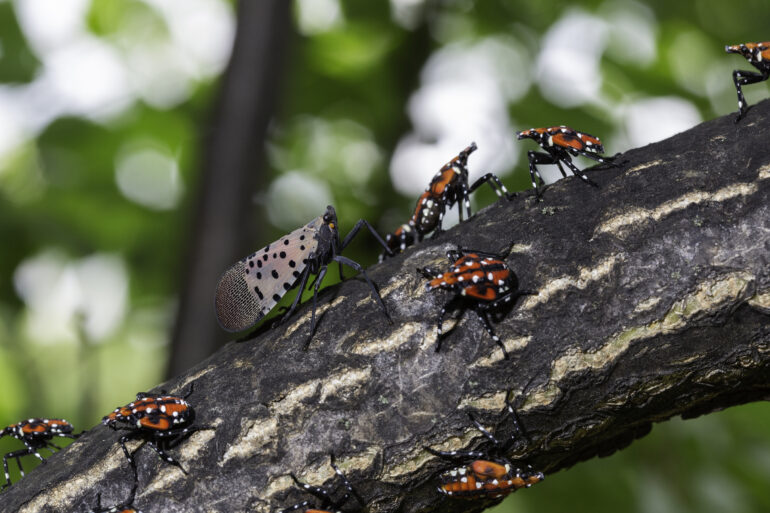The spotted lanternfly is a type of planthopper native to Asia. In its adult stage, it is about an inch long with distinctive markings: gray forewings with black spots and bright red hindwings with black and white patches. The nymphs, or young insects, go through several stages, initially appearing black with white spots before developing red patches in their final nymphal stage.
These insects are not strong flyers, but they are excellent “hitchhikers.” They lay their egg masses—which look like a smear of gray, dried mud—on nearly any surface, including trees, rocks, outdoor furniture, and vehicles. This allows them to be transported easily over long distances, which is the primary reason for their rapid spread.
What is the Spotted Lanternfly?

The spotted lanternfly is a type of planthopper native to Asia. In its adult stage, it is about an inch long with distinctive markings: gray forewings with black spots and bright red hindwings with black and white patches. The nymphs, or young insects, go through several stages, initially appearing black with white spots before developing red patches in their final nymphal stage.
These insects are not strong flyers, but they are excellent “hitchhikers.” They lay their egg masses—which look like a smear of gray, dried mud—on nearly any surface, including trees, rocks, outdoor furniture, and vehicles. This allows them to be transported easily over long distances, which is the primary reason for their rapid spread.

Areas in the United States that have been identified as possible spotted lanternfly habitat.
The Impact on Ohio
The spotted lanternfly is a type of planthopper native to Asia. In its adult stage, it is about an inch long with distinctive markings: gray forewings with black spots and bright red hindwings with black and white patches. The nymphs, or young insects, go through several stages, initially appearing black with white spots before developing red patches in their final nymphal stage.
These insects are not strong flyers, but they are excellent “hitchhikers.” They lay their egg masses—which look like a smear of gray, dried mud—on nearly any surface, including trees, rocks, outdoor furniture, and vehicles. This allows them to be transported easily over long distances, which is the primary reason for their rapid spread.
Ohio’s Response and What It Means for You
The Ohio Department of Agriculture (ODA) is working to slow the spread of the spotted lanternfly through a multi-pronged strategy. This includes establishing quarantine areas in affected counties to regulate the movement of certain items—like nursery stock, firewood, and outdoor equipment—that could harbor the pest.
If you live in or are traveling through a quarantined county, the biggest takeaway is this: be extra vigilant. The quarantine primarily impacts businesses, which must have special permits to move regulated items. However, citizens also have a crucial role to play. Before you leave a quarantined county, do a quick “once-over” of your vehicle, trailer, or any outdoor items you’re taking with you. This simple check can prevent a new infestation from taking hold in a different part of the state. To find out which counties are currently under quarantine, you can always check the ODA’s official website.
How You Can Help Right Now
Fighting the spotted lanternfly isn’t a job just for state officials and entomologists—it’s a community-wide effort. The good news is, there are a few simple but incredibly effective steps every single one of us can take to help slow the spread and protect our state.
1. Become a “Spotter”: The first and most important thing is to be on the lookout. Spotted lanternflies are most active from now through the late fall. Look for the insects themselves, but also know what their egg masses look like. They’re often laid on trees, cars, patio furniture, and even firewood—anything with a smooth, flat surface. The masses look like a splotch of grayish mud or putty, and they’re tough to spot if you don’t know what you’re looking for.
2. Report Your Sightings: This step is critical for tracking the bug’s movement. If you find a spotted lanternfly or an egg mass in a county where the pest hasn’t been widely reported yet, your report helps experts know where to focus their efforts. Snap a picture, note the location, and report it to the Ohio Department of Agriculture through their online Plant Pest Reporter or a mobile app like EDDMapS Great Lakes Early Detection Network. You can also contact them directly at [email protected].
3. Be a Smart Traveler: The spotted lanternfly is an expert hitchhiker. They can easily catch a ride on vehicles, trailers, or outdoor equipment. Before you leave a quarantined area—or even your own yard—take a few moments to do a quick check of your car, truck, or anything you’re moving. By being vigilant, you can prevent accidentally transporting this pest to a new part of the state.
4. The “Squish It” Rule: When you hear about the spotted lanternfly, you’ll inevitably hear a simple but firm instruction: “If you see one, squish it.” This isn’t just a catchy phrase; it’s the most powerful tool we have right now. These pests have no natural enemies here in Ohio, so killing them is the most effective and immediate control method. Every single citizen can help reduce the population on the spot.
5. Scrape Egg Masses: In the fall and winter, spotted lanternflies are less active, but their egg masses are a major threat. They are laid on nearly any flat surface, and look like a smear of grayish mud. You can scrape them off with a credit card or a putty knife into a bag or container filled with hand sanitizer or rubbing alcohol to destroy them.
By taking these simple steps, you become a vital part of Ohio’s defense against this invasive species. Every person who looks, reports, and acts makes a real difference in protecting our state’s valuable crops and forests.
